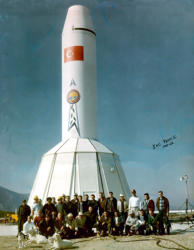HISTORY - Page 41
equipment. If this were done, the first firing unit with two launchers and four missiles could be ready for
deployment by July 1958. To achieve that goal, REDSTONE ground equipment would be converted and
oncoming REDSTONE personnel scheduled for unit training would be trained and used to initially employ
the JUPITER. Training would start immediately for Air Force personnel, and they could take over the firing
unit about January 1959. The balance of the first firing group, consisting of either six or 15 launchers, could
be manned with Air Force personnel or a mix with Army personnel by the end of the first quarter of 1959.
From there, squadrons or mobile groups could follow at the rate of one per quarter, beginning with the
second quarter of 1959
53
.
For a time, it appeared that the program might go along the lines suggested by the General, even to the
point that a Holaday paper was circulating in Washington to the effect that Army personnel could man the
first employed missiles. The Air Force immediately complained of this matter to the Secretary of the Air
Force, who, in turn, went to Secretary of Defense Neil McElroy and the Holaday paper was recalled. At that
time, the situation was rather fluid, as the Air Force was in the process of a reorganization. Previously,
AFBMD was to have exercised operational control over the IOC missiles, but, in early December, this
responsibility was about to pass to the Strategic Air Command (SAC). Thus, a deployment manner was
almost impossible to determine. One item, however, appeared a certainty, as the Air Force, in general, did
not favor the Army's mobility concept based on the alleged fact that the countries in which the missile
_____________________________







53. DF, Cont Off to Dev Opns Div, et. al., 25 Nov 57, subj: Early Opnl Capability, Hist Off files.



Jupiter SM-78 Weapon System
I&C Team 2, Çigli AB, Turkey 1961-1962 Chrysler Corporation Missile Division

HISTORY - Page 41
equipment. If this were done, the first firing unit with
two launchers and four missiles could be ready for
deployment by July 1958. To achieve that goal,
REDSTONE ground equipment would be converted
and oncoming REDSTONE personnel scheduled for unit
training would be trained and used to initially employ
the JUPITER. Training would start immediately for Air
Force personnel, and they could take over the firing
unit about January 1959. The balance of the first firing
group, consisting of either six or 15 launchers, could
be manned with Air Force personnel or a mix with
Army personnel by the end of the first quarter of 1959.
From there, squadrons or mobile groups could follow
at the rate of one per quarter, beginning with the
second quarter of 1959
53
.
For a time, it appeared that the program might go
along the lines suggested by the General, even to the
point that a Holaday paper was circulating in
Washington to the effect that Army personnel could
man the first employed missiles. The Air Force
immediately complained of this matter to the
Secretary of the Air Force, who, in turn, went to
Secretary of Defense Neil McElroy and the Holaday
paper was recalled. At that time, the situation was
rather fluid, as the Air Force was in the process of a
reorganization. Previously, AFBMD was to have
exercised operational control over the IOC missiles,
but, in early December, this responsibility was about
to pass to the Strategic Air Command (SAC). Thus, a
deployment manner was almost impossible to
determine. One item, however, appeared a certainty,
as the Air Force, in general, did not favor the Army's
mobility concept based on the alleged fact that the
countries in which the missile
_____________________________
53. DF, Cont Off to Dev Opns Div, et. al., 25 Nov 57, subj: Early Opnl Capability, Hist Off files.





















